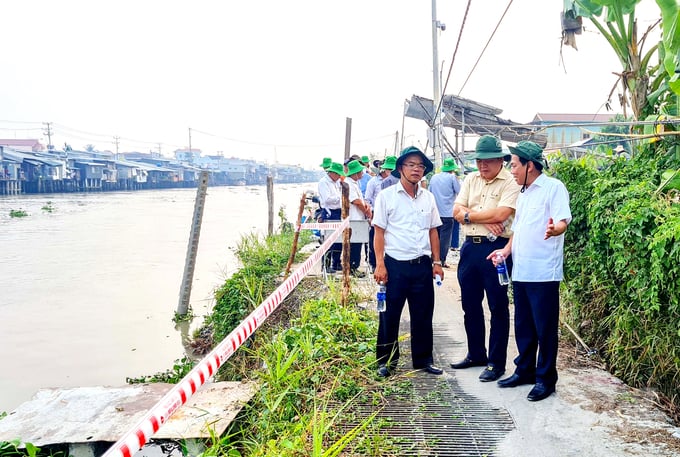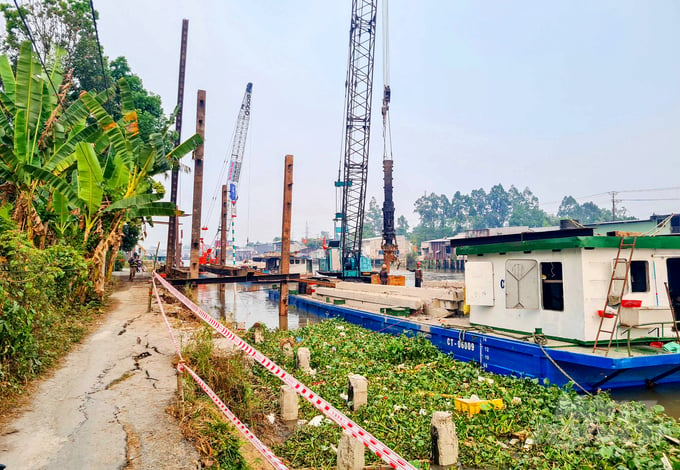November 26, 2025 | 01:29 GMT +7
November 26, 2025 | 01:29 GMT +7
Hotline: 0913.378.918
November 26, 2025 | 01:29 GMT +7
Hotline: 0913.378.918

Leaders of Can Tho city inspecting local erosion sites. Photo: Le Hoang Vu.
Numerous severe erosion sites have recently been discovered along river routes in Binh Thuy district and Thoi Lai district of Can Tho city, resulting in heavy damage to roads and the properties of local residents.
The most recent erosion site was reported in early February 2024, on the left side of the Tra Noc riverbank (in the direction of the Hau River) in Thoi An Dong ward, Binh Thuy district, Can Tho city.
The reported section suffered from severe erosion, with a length of approximately 25 meters and a width of approximately 7 meters from the riverbank inward. The erosion site is located adjacent to four households, necessitating urgent relocation to ensure the residents' safety and protect their property. The erosion has effectively disrupted the local residential road.
Ms. Nguyen Thi Thuy Diem, one of the residents in the affected households, revealed that cracks had appeared in the foundation of her house beforehand, indicating imminent erosion. Consequently, they had evacuated their belongings and proceeded to dismantle the house. The erosion occurred several hours later, causing both her house and the neighboring house, along with the concrete road in front of their houses, to collapse into the river. Ms. Diem's family has moved to temporary accommodations to ensure safety due to a risk of further erosion affecting the remaining nearby houses.
Mr. Nguyen Qui Ninh, Head of the Office of the Command of Civil Defense - Natural Disaster Prevention and Search and Rescue of Can Tho city, shared that local erosion sites are rapidly exacerbated by activities that increase the load on the riverbanks, such as construction of residential houses, land filling encroachments into riverbeds, sand mining for land reclamation for road construction, or sand mining for house building.
Furthermore, numerous residential houses are constructed dangerously close to the riverbanks, with some encroaching directly into the riverbed, along various river routes in Can Tho city, including the Tra Noc river, Binh Thuy river, O Mon river, Cai San river, Tac Ong Thuc canal, Thom Rom channel.

With 250 billion Vietnamese dong from the Central Government, Can Tho city is investing in urgent riverbank erosion prevention projects from 2023 to 2024. Photo: Le Hoang Vu.
In response to the riverbank erosion, and as an effort to mitigate the damages, Can Tho city has implemented various measures within the last few years. These activities include raising public awareness through extensive campaigns, installing warning signs at dangerous erosion sites, creating predictive maps of erosion-prone areas, and providing financial support to address erosion consequences.
Furthermore, the city has been actively constructing sturdy embankments to combat erosion, reinforcing vulnerable erosion sites, with a total length of over 12,500 meters. Namely, the solid concrete-reinforced embankments stretch over 8,500 meters, with a total investment of over 848 billion Vietnamese dong.
Most notably, the city recently received an additional 250 billion dong from the Central Government. Subsequently, the city is expediting investment in critical riverbank erosion prevention projects across the area from 2023 to 2024.
Erosion sites along major rivers, characterized by complex terrain and rapid erosion, such as the Can Tho river, Tra Noc river, Binh Thuy river, O Mon river, and various islets and aits in the Hau River, pose dangerous erosion risks and require prioritized investment in sturdy embankments.
Regarding regular erosion sites along smaller canals and streams, erosion can be addressed through simple structures such as rudimentary embankments made from local materials (coconut wood, eucalyptus, or timber in combination with rocks and geotextile fabric), the installation of warning signs and the relocation of residents, suggested Mr. Nguyen Qui Ninh.
According to the Command of Civil Defense - Natural Disaster Prevention and Search and Rescue of Can Tho city, 39 incidents of riverbank erosion were reported citywide in 2023, marking an increase of 30 cases compared to the same period in 2022. Notably, 35 incidents occurred across seven districts and townships within just three months from May to July 2023. The affected areas include Cai Rang, Binh Thuy, O Mon, Thot Not, Phong Dien district, Thoi Lai district, and Vinh Thanh district. The total length of erosion sites reached nearly 2,100 meters, causing an estimated property damage amount of at least 30 billion Vietnamese dong.
Translated by Nguyen Hai Long
/2025/11/24/3536-2-112800_176.jpg)
(VAN) Dong Nai now has tens of thousands of hectares of forests certified for sustainable management, and this area will continue to be expanded in the coming period.

(VAN) Vinh Ha hamlet (Dai Xuyen commune, Hanoi) is shifting away from small-scale farming as households adopt bioscurity into their breeder chicken models.

(VAN) Heavy rains make aquatic species more vulnerable to disease. Proactive water management and high-tech systems help farmers prevent outbreaks and protect yields.

(VAN) Greenhouses are shifting production mindsets in Binh Lu commune, enabling farmers to ‘weather the sun and rain’ and secure stable vegetable harvests throughout the year.

(VAN) Green transition is crucial for the Mekong Delta amid climate change and stricter standards, offering a path toward sustainability.

(VAN) Dong Thap promotes agricultural restructuring, forms large specialized farming zones, raises the value of agricultural products and develops toward ecological and high-tech directions.
/2025/11/22/4018-4-213342_747.jpg)
(VAN) The Mekong Delta Agricultural Experts Club has attracted 143 experts and researchers to participate in providing consultancy and contributing initiatives to the development of one million hectares of high-quality rice.